89 15.1 Factors That Control Slope Stability
The potential for mass movement is important to consider when managing natural hazard risks to people and property. To understand the risks posed by mass movement, we first need to understand what makes a slope stable or unstable, and what can trigger materials to move.
Slope Angle and the Forces Acting On A Slope
A block of rock situated on a rock slope is pulled by gravity toward Earth’s centre (vertically down, Figure 15.2). We can split the vertical gravitational force into two components (vectors) relative to the slope: one pulling the block down parallel to the slope (the shear force), and the other pulling the block directly into (i.e., perpendicular) to the slope (the normal force).
The shear force pulls the block down the slope, but the block doesn’t move unless the shear force overcomes the strength of the bond between the block and the slope. The block might be only weakly connected, with friction being most important for keeping it there, or the block might still be part of the rock with more force being required to break it away. The strength of the relationship between the block and the slope is called the shear strength. For the gentle slope in Figure 15.2, the shear strength is greater than the shear force, so the block doesn’t move. For the steeper slope, the shear force is greater (even though the rock weighs the same), and the block slides downhill.

Slopes are created by uplift in the Earth’s crust, and modified by erosion. In areas with relatively recent uplift (such as most of British Columbia and the western part of Alberta in Canada), slopes tend to be quite steep. This is especially true where glaciation has taken place because glaciers in mountainous terrain create steep-sided U-shaped valleys. In areas without recent uplift (such as central Canada), slopes are less steep because erosion—including mass wasting—has been acting on the slopes for a long time. Note that mass wasting can happen even on relatively gentle slopes if the shear stress acting on the materials is greater than the materials’ shear strength.
Slope Strength in Rocks
Solid rocks tend to be strong, but rock strength varies widely. If we ignore issues such as fracturing and layering, then most crystalline rocks (e.g., granite, basalt, or gneiss) are very strong, while some metamorphic rocks (e.g., schist) are only moderately strong. Sedimentary rocks have variable strength. Dolostone and some limestone are strong, most sandstone and conglomerate are moderately strong, but there are some sandstones that are weak, and all mudstones are weak.
Fractures, metamorphic foliation (excluding banding in gneiss), or bedding can significantly reduce the strength of rock. In the context of mass wasting, these structures—which constitute planes of weakness—are parallel to the slope. In Figure 15.3, the bedding is almost perpendicular to the slopes at locations A and B. At location C, the bedding is nearly horizontal, and at location D it’s actually parallel to the slope (a worrisome scenario). If these rocks gave out along their bedding planes, the most likely outcome is that the hill between B and C would slide along a bedding plane into the valley between C and D, as would one or more of beds making up the slope at D.
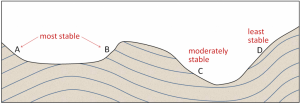
Internal variations in the composition and structure of rocks can significantly affect their strength. Schist, for example, may have layers that are rich in sheet silicates (micas) and these will tend to form weak layers.
Some minerals are more susceptible to weathering than others, and the weathered products are commonly quite weak (e.g., clay formed from feldspar). The side of Johnson Peak that failed in 1965 (Hope Slide) is made up of chlorite schist (metamorphosed sea-floor basalt) that has feldspar-bearing sills within it. The foliation and the sills are parallel to the steep slope. The schist is relatively weak to begin with, and the feldspar in the sills, which has been altered to clay, makes it even weaker.
Slope Strength in Unconsolidated Sediments
Unconsolidated (loose) sediments are generally weaker than sedimentary rocks because they’re not cemented and, in most cases, have not been significantly compressed by overlying materials. Unconsolidated sediments can still bind together, and the strength of that binding is called cohesion. A cohesive sediment binds together strongly, and if you picked it up with a shovel it would stick together in a lump (e.g., sand mixed with clay, clay). A sediment that’s not very cohesive is weakly bound and would probably fall apart if you picked it up with a shovel (e.g., sand, silt).
The deposits that make up the cliffs at Point Grey, Vancouver, B.C. include sand, silt, and clay, overlain by sand. The finer deposits at Point Grey are relatively cohesive (they maintain a steep slope, Figure 15.4 left). The overlying sand is not very cohesive (relatively weak) and has a shallower slope because there are many slope failures in the sand deposit.
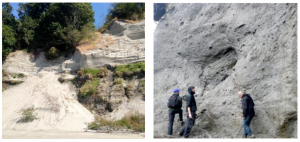
In contrast to poorly cohesive sediment deposits, glacial till can be as strong as some sedimentary rock. Glacial till is typically a mixture of clay, silt, sand, gravel, and larger clasts and forms and is compressed beneath tens to thousands of metres of glacial ice (Figure 15.4, right).
Angle of Repose
The steepness of a hill of unconsolidated material will depend on how well the material can withstand the force of gravity. The steepest possible angle that a slope can have and still be stable is called the angle of repose. The angle of repose will depend on many factors that govern how well sediment particles can stay together in a pile, but generally speaking, the smaller the grain size, and the more irregularly shaped the particles are, the higher the angle of repose. In Figure 15.5, the sand pile with a 39º angle of repose has smaller grains than the piles with 37º or 31º angles of repose.
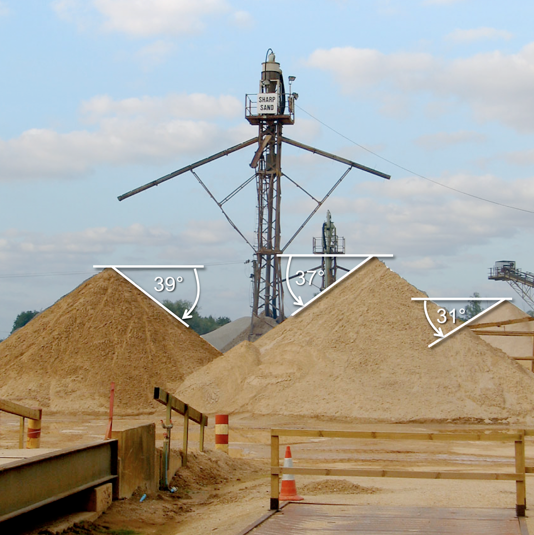
Importance of Water in Slope Stability
Apart from the type of material on a slope, the amount of water that the material contains is the most important factor controlling its strength. This is especially true for unconsolidated materials, but it also applies to bodies of rock. Granular sediments, like the sand at Point Grey, have lots of pore spaces between the grains. These spaces may be completely dry (filled only with air), moist (some spaces are water filled), or completely saturated (Figure 15.5).
![Depiction of dry, moist, and saturated sand [SE]](https://pressbooks.bccampus.ca/suicideawareness/wp-content/uploads/sites/1483/2021/08/Depiction-of-dry-moist-and-saturated-sand.png)
Water can increase the mass of the material on a slope, because the mass of the water is a component of the overall mass of the slope material. This increases the gravitational force pulling the slope materials down. A water saturated body of sediment with 25% porosity weighs approximately 13% more than it does when it is completely dry, so the gravitational shear force is also 13% higher. In the situation where the shear force and shear strength are closely matched, even a small change in shear force is enough to overcome the shear strength, and the block would move down the slope.
Sometimes Water Helps Stability
Unconsolidated sediments tend to be strongest when moist, because the small amounts of water at grain boundaries holds the grains together due to surface tension. Surface tension is the reason a droplet of water is dome-shaped rather than completely flat, and the reason some insects can walk on top of water.
Dry sediments are held together only by the friction between grains. If the grains are well sorted, well rounded, or both, this cohesion is weak, because of minimal grain contact (i.e., the grains only touch in a few places).
Saturated sediments tend to be the weakest of all because the water pushes the grains apart, decreasing friction between grains. Saturating a solid rock with water can also decrease its strength, especially if the rock has porosity, fractures, bedding planes, and/or clay-bearing zones.
A sand castle (Figure 15.6) is an excellent example of the role of water in slope stability. Without water, the sand would be held up by friction between the grains alone, and would have the same shape as the sand piles in Figure 15.5. With too much water, the sand grains will be separated from each other by a layer of water, reducing the friction between the grains. That sand would slide into a sloppy puddle.
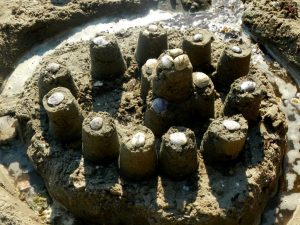
Water and Clay Minerals
Water also has an interesting effect on clay-bearing materials. All clay minerals will absorb a small quantity of water, which reduces the strength of the clay. The smectite clays (such as the bentonite used in cat litter) can absorb a lot of water, and this water pushes the clay sheets apart at a molecular level, which makes the clay swell. Smectite that has expanded in this way has almost no strength; it’s extremely slippery. Thus, slopes containing smectite clay are more likely to experience slope failure when they are saturated.
Water Pressure
Water pressure is an important factor in slope failure. As you move deeper in saturated sediment, the pressure of the water goes up due to gravity acting on the column of water above it. This pressure is called hydrostatic pressure. The greater the depth below the surface of the water table (the point where the rock or sediments are saturated), the greater the water pressure acting on the materials.
Holes are often drilled into rocks in road cuts to allow water to drain and relieve this water pressure. One of the hypotheses advanced to explain the 1965 Hope Slide is that cold conditions that winter caused small springs in the lower part of the slope to freeze, preventing water from flowing out. It’s possible that water pressure gradually built up within the slope, weakening the rock mass to the extent that the shear strength was no longer greater than the shear force.
Triggers of Mass Wasting
Shear force is primarily related to slope angle, and once a slope angle is set, the shear force is constant. But shear strength can change quickly for a variety of reasons. Events that lead to a rapid decrease in shear strength are triggers for mass wasting.
An increase in water content is the most common trigger of mass wasting. This can result from rapid melting of snow or ice, heavy rain, or other events that change the pattern of water flow on and through the material. Rapid melting can be caused by a sudden increase in temperature (e.g., in spring or early summer), or by a volcanic eruption that melts snow and ice on a mountain top. Heavy rains are typically related to storms. The Oso landslide that occurred in Washington State, USA in 2014 (Figure 15.7) is an example of slope failure triggered by heavy rain. The flow buried the community of Steelhead Haven, killing 43 people. River erosion at the base of the slope made it even more susceptible to failure.
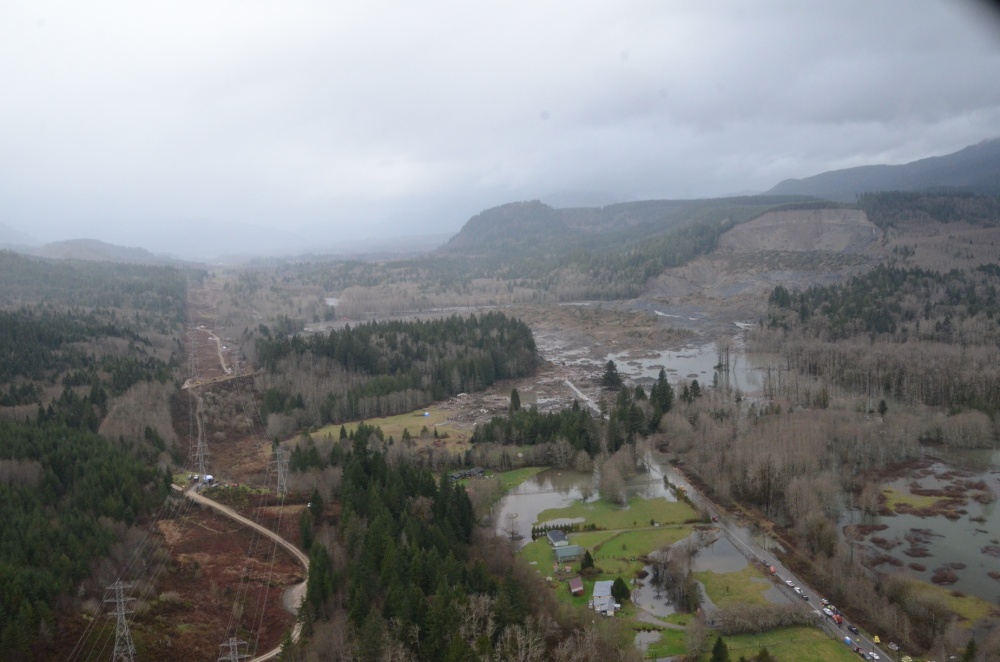
Changes in water flow patterns can be caused by earthquakes, dammed streams from previous slope, or human structures that interfere with runoff (e.g., buildings, roads, or parking lots). An example of this is a deadly 2005 debris flow in North Vancouver, B.C. There had been previous slope failures in the area, and a report written in 1980 recommended that the municipal authorities and residents take steps to address surface and slope drainage issues. Unfortunately, little was done to address the issues. The failure happened during a rainy period but was likely triggered by excess runoff related to the roads at the top of this slope, and by landscape features including addition of fill to backyards in the area above the failure.
In some cases, a decrease in water content can lead to failure. This is most common with clean sand deposits (e.g., the upper layer in Figure 15.4 (left)). As water content drops, the surface tension holding grains together decreases.
Freezing and thawing can also trigger some forms of mass wasting. A block of rock might fall because of ice wedging, or thawing might release a block of rock that was frozen to a slope by a film of ice.
One other process that can weaken a body of rock or sediment is shaking. The most obvious source of shaking is an earthquake, but shaking from highway traffic, construction, or mining can also weaken rock. Several deadly mass wasting events (including snow avalanches) were triggered by the M7.8 earthquake in Nepal in April 2015.

